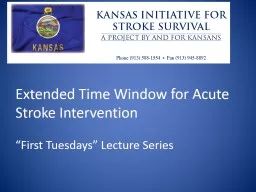

Train the trainercontent reviewed from Extended Time Window for Acute Stroke Intervention First Tuesdays Lecture Series Introduction and Goal of First Tuesdays Sabreena Slavin ID: 779637
Download The PPT/PDF document "Update from education committee" is the property of its rightful owner. Permission is granted to download and print the materials on this web site for personal, non-commercial use only, and to display it on your personal computer provided you do not modify the materials and that you retain all copyright notices contained in the materials. By downloading content from our website, you accept the terms of this agreement.
Slide1
Update from education committee
Train the trainer—content reviewed from
Extended Time Window for Acute Stroke Intervention“First Tuesdays” Lecture Series
Slide2Introduction and Goal of “First Tuesdays”
Sabreena
Slavin MD – Vascular Neurologist and Neurohospitalist at KU School of MedicineCraig Bloom RN, BSN, MBA – Senior Clinical Specialist
Lytics
, Genentech, Inc.
Didactic lecture series as part of the Kansas Initiative for Stroke Survival
Updates in Practice and FAQ’s on Acute Stroke Care
20 minute didactic, 10 minutes for questions/discussion.
Slide3Review of Acute Stroke Interventions
IV alteplase (tPA
) for all patients who have disabling symptoms of acute strokeMechanical thrombectomy: only for large vessel occlusions (LVO). Only hospitals with capabilities (eg: comprehensive stroke center) can perform thrombectomy.
A higher NIHSS (10 or more) can be indicative of a large vessel occlusion.
Diagnosed with CTA head/neck
Slide4Extended Time Window
Time limit for IV tPA: 4.5 hours from last known normal. This is unchanged.Time limit for mechanical
thrombectomy: Previously was up to 6 hours from last known normal. Now can take up to 24 hours from last known normal. This is a new change in recommendation based on recent studies.
Slide5From the 2018 Guidelines for Management of Acute Ischemic Stroke
New recommendations, class I, level A: “In selected patients with AIS within
6 to 24 hours of last known normal who have LVO in the anterior circulation, obtaining CTP, DW-MRI, or MRI perfusion is recommended to aid in patient selection for mechanical
thrombectomy
, but only when imaging and other eligibility criteria from RCTs showing benefit are being strictly applied in selecting patients for mechanical
thrombectomy
.”
Based on DAWN and DEFUSE 3 trials
Powers et al,
Stroke,
2018
Slide6Perfusion Imaging
CT perfusion and MR perfusion imaging is used to find a mismatch between ischemic core (area already damaged) and ischemic penumbra (area at risk of damage).Measures of core: cerebral blood volume, cerebral blood flow
Measures of penumbra: mean transit time (ratio cerebral blood flow/cerebral blood volume), time to peak, time to drain, and Tmax (measures of contrast arrival time to tissue).
Slide7Radiopedia
,
https://radiopaedia.org/articles/ct-perfusion-in-ischaemic-stroke
Slide8RAPID software to analyze core and penumbra:
iSchemaView RAPID:
www.irapid.com
Slide9DAWN Trial
Enrolled patients 6 to 24 hours after last known well with prestroke mRS 0-1 and with ICA or M1 occlusion.
Imaging inclusion criteria: clinical-core mismatchIf greater than 80, needed NIHSS ≥ 10 and core volume ≤ 20 mLIf less than 80 and NIHSS ≥ 10, needed core volume ≤ 30 mLIf less than 80 and NIHSS ≥ 20, needed core volume 31 to 50 mL.
Max core volume should be 50
mL.
Randomized 1:1 to
thrombectomy
vs standard medical care.
Nogueira
et al,
NEJM,
2018
Slide10Results of DAWN Trial
Nogueira
et al,
NEJM,
2018
Slide11DEFUSE 3 Trial
Enrolled patients 6 to 16 hours post last known well with prestroke
mRS 0-2 and with ICA or M1 occlusion. Max age 85, NIHSS ≥ 6. This included a broader population than DAWN.Imaging inclusion criteria: perfusion-core mismatch.Core < 70 mL, mismatch ratio > 1.8 and mismatch volume ≥ 15 mL
Randomized 1:1 to
thrombectomy
vs standard medical care.
Albers et al,
NEJM,
2018
Slide12DEFUSE 3 Trial Results
Albers et al,
NEJM,
2018
Slide13How this translates
EMS:
Use prehospital triage scales for LVO, including FAST-ED, for all patients with suspected stroke within 24 hours. Communicate with ED prior to arrival. If suspecting an LVO, stay near ED to facilitate further transport if necessary for fast door-out time.
Community ED:
If higher NIHSS, please obtain ASPECTS from CT scan. Consider CTA/CTP imaging if resource available.
Call endovascular-capable center early if suspecting LVO to facilitate transport.
Slide14Bottom Line
There is now evidence that mechanical thrombectomy
can provide benefit for patients up to 24 hours after last seen at baseline if they fit imaging criteria. Both DAWN and DEFUSE 3 used strict criteria – in actual clinical practice, can consider extended window thrombectomy on patients that may not strictly fit study criteria (eg: M2 occlusion, greater core volume than 70 mL, older age,
etc
) on case by case basis.
Still give IV
tPA
if able! Do not delay IV
tPA
to get advanced imaging.
Consider all ways to obtain thrombectomy asap: prehospital scales, communication between EMS, community ED, and stroke center.
Slide15Questions?Call for help anytime!
http://www.kissnetwork.us/KU BAT phone: 913-588-3727